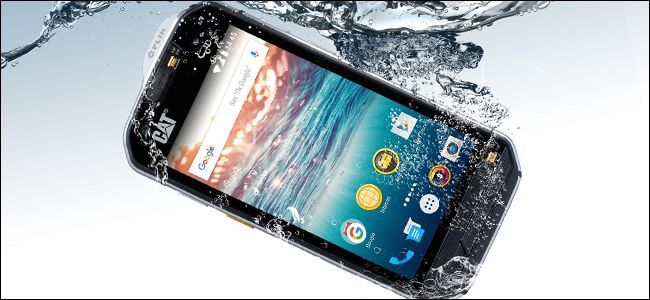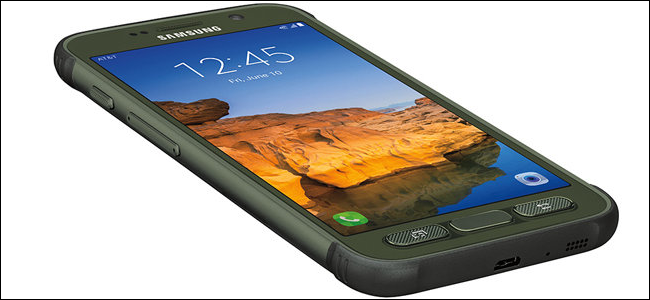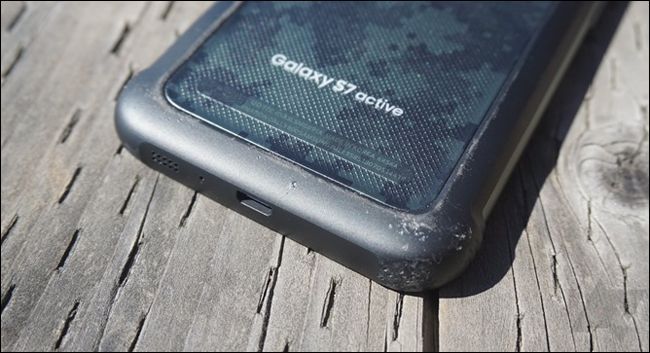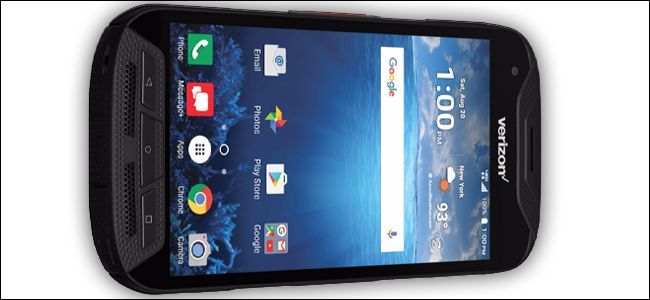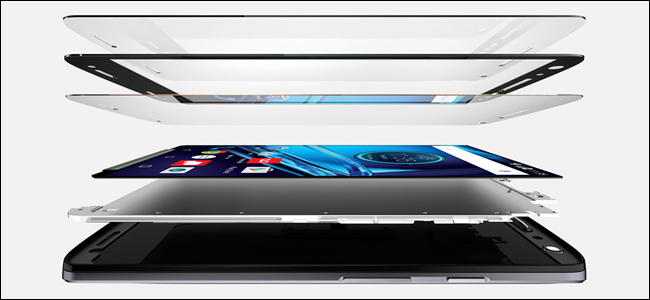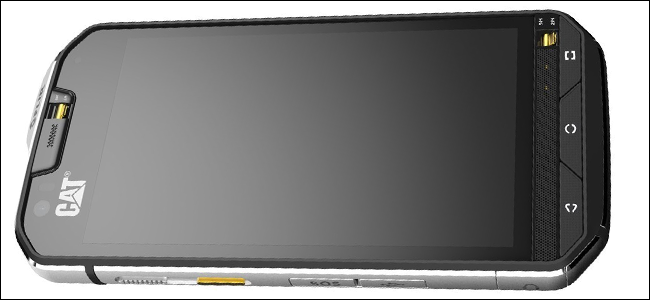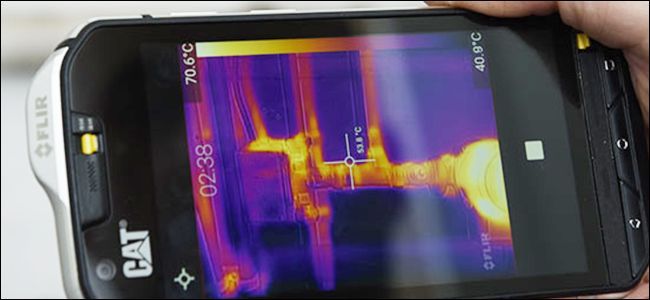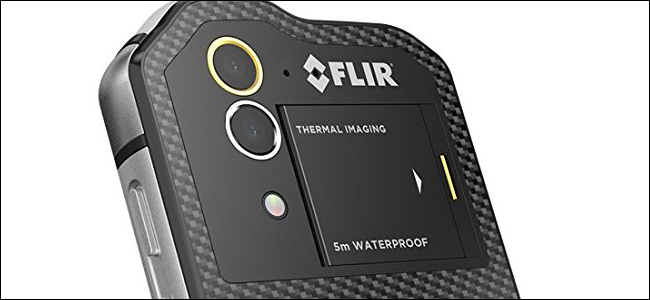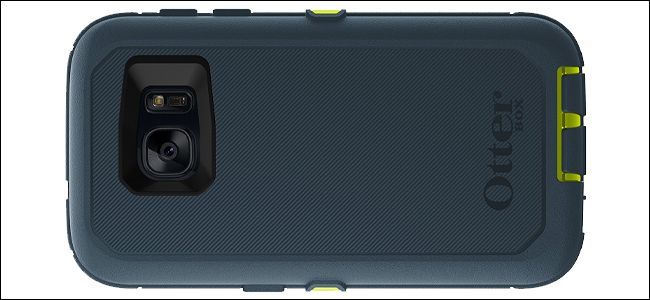Quick Links
If those incredibly masculine pickup truck commercials seem tame to you, if you work at a job with more OSHA inspectors than actual employees, and if you've broken more smartphone screens than human bones at your local half pipe, you might be in the market for a rugged phone. These toughened-up models come with extra protection from impacts, water damage, and other otherwise lethal threats to more mortal smartphones.
Unfortunately, picking a smartphone that's tough-as-nails often means compromising on some other features, and they're hard to find even among today's huge carrier retail selections. Here are the best picks on the market right now for each US carrier.
AT&T: Galaxy S7 Active
Ma Bell seems to be the only carrier that's really interested in offering a premium "tough" phone as part of its retail lineup---it's been the exclusive US vendor for almost all of the Active variants of the Samsung Galaxy line for years. The latest one is from back in 2016, the Galaxy S7 Active. It's likely to be replaced in a few months with an updated S8 model, but even now it's an excellent overall choice.
The Galaxy S7 Active is, more or less, the same phone as the Galaxy S7, in a super-protective shell. It has the same 2560x1440 Super AMOLED screen, the same Snapdragon 820 processor, the same 32GB of storage space and 4GB of RAM, the same fingerprint sensor in the home button, the same excellent 12-megapixel rear camera. It's even running a relatively recent version of Android, 6.0, and should be upgraded to 7.0 at some point. The beefier plastic body does let Samsung cram in a 4000mAh battery (one third larger than the normal S7). On top of that, it can withstand five feet (1.5 meters) of water pressure for up to half an hour, any amount of dust or sand, and the polymer-reinforced screen is rated for a five-foot drop onto a flat surface without cracking.
You wouldn't call the S7 Active "pretty," but Samsung has put a lot of work into making the case much smaller and sleeker than similar rugged designs. Its' a combination of aluminum and plastic with reinforced impact zones at the corners. As it happens, I put this phone through its paces myself over at Android Police, subjecting it to a battery of tests including a full laundry cycle and 20-foot drops onto concrete. It survived, with a few scars and a lot of bragging rights.
The Galaxy S7 Active is $695 (though you can get one with a payment plan from AT&T), easily the most expensive phone on this list. But it's also definitely the best, especially if you don't want to compromise on specifications or creature comforts. (Note, though, that the CAT phone mentioned at the end of this post also works on AT&T, if you prefer something non-Samsung.) There's a newer, cheaper option from LG, the "X Venture," that has a similar rugged MIL-STD 810 body with mid-range specs. This phone has only a 1080p screen and just a Snapdragon 435/2GB combo, but the cheaper $330 price tag will be more appealing to anyone who needs a little durability on a budget.
T-Mobile: None (Buy Unlocked)
At the time of writing, T-Mobile doesn't offer a single "ruggedized" phone in its retail lineup. You'll have to buy an unlocked GSM-compatible phone yourself and stick your SIM card in. Options include the Galaxy S7 Active above (though you'll have to buy it outright from AT&T and get the carrier lock removed) or the CAT models below. Previously the carrier sold the Kyocera DuraForce XD, an older and larger version of the PRO phones below, which you might be able to find secondhand.
Verizon: Kyocera DuraForce PRO With Sapphire Shield
Customers on Big Red have a whole two choices when it comes to rugged phones, which is a stunning variety in this very narrow field. At the moment, the carrier is selling the Kyocera DuraForce PRO, a phone that offers a rare synthetic sapphire screen, and the older Motorola DROID Turbo 2, which claims to be "shatterproof."
The DuraForce PRO has more going for it than the sapphire display, which should resist scratches from anything except diamonds. It's also submersible in up to 6.5 feet of water for half an hour, can repel dust and dirt, operates in temperature extremes, all that jazz. The screen can even work while underwater or through gloves. On top of that, the hardware's not half bad: a Snapdragon 617 processor is paired to 3GB of RAM and 32GB of storage, including a MicroSD card slot. That battery is a generous 3240mAh, which should keep it going for a while with a 5-inch 1080p screen, and the rear camera is a full 13 megapixels. The phone runs Android 6.0, but don't hold out for a Nougat upgrade, since Kyocera isn't known for its software prowess. It goes for $408 outright---pretty reasonable for a carrier-branded phone---or $17 a month on a payment plan.
The DROID Turbo 2 isn't rugged in the classical sense, it's more of an honorable mention. The Verizon flagship from 2015 is still being sold, and it's actually been upgraded to Android 7.0. Motorola uses a mixture of high-quality polycarbonate layers (not tempered glass) to create its patented "ShatterShield" screen, which it claims is basically unbreakable by any normal means. If the outer layer gets scratched, Motorola sells a user-replaceable top (basically an extra-tough screen protector) for thirty bucks. The rest of the phone isn't especially tough, but it's more than serviceable, and the big 3760mAh battery will be enough to win some fans on its own. The DROID Turbo 2 goes fro $528 outright or $22 a month.
Sprint: Kyocera DuraForce PRO
Sprint is offering the sane model of rugged phone as Verizon: the Kyocera DuraForce PRO. This model has there same specifications and protection as the Verizon model, with one huge exception: only Verizon gets the fancy synthetic sapphire screen. The Sprint model has to make do with Corning's (still quite serviceable) tempered Gorilla Glass. Despite the lack of fancy screen tech, Sprint's model is slightly more expensive at $432 or $18 a month. Bummer.
Unlocked: CAT S60
Perhaps the most dramatic entry on this list is the CAT S60. Yes, that CAT---the manufacturer of construction equipment. Caterpillar international doesn't actually manufacture the phone itself, licensing its brand name to UK-based Bullitt Group, but it's hard to deny that this thing will appeal to anyone who wants a phone that can take a massive beating and still play Angry Birds.
The chunky metal-and-carbon fiber frame is resistant to water at up to five meters (sixteen feet) for up to an hour so long as you remember to lock down the switches on the front and back of the device. It's impervious to a six-foot drop and pretty much anything that isn't delivered via gunpowder combustion, and it works at temperatures below zero and above 130 degree Fahrenheit. The speakers can even go into a high frequency mode to quickly cycle water out. What makes the S60 completely unique (and different from the older and much cheaper S40, also unlocked) is that it includes a built-in FLIR thermal camera for taking images images of hot and cold surfaces. Why would you need that? If you have to ask, you probably don't, but it comes in handy for a lot of industrial applications.
All that protection doesn't leave much room for a screen, and the one behind the toughened Gorilla Glass of the CAT S60 is only 4.7 inches and 720p. The rest of the specs are much more agreeable, including a Snapdragon 617 processor, 3GB of RAM, 32GB of storage plus a MicroSD card slot, a conventional 13 megapixel camera that can augment the detail of the thermal cam, and Android 6.0. The battery is capacious at 3800mAh, and combined with the small screen and efficient processor should run the phone for two full days at least.
All that protection and the FLIR camera comes at a price, and it's $630 retail. The US version of the phone comes with bands specifically supported by AT&T, T-Mobile, and their various MVNO partners, while the international model has more generic GSM-LTE support. Verizon and Sprint customers are out of luck, since there's no CDMA variant.
Another Option: Super-Protective Cases
If none of the above appeal to you, and you'd rather have a larger choice of smartphone, you have another option: a deluxe phone case. These elaborate designs are meant to give a standard phone increased protection for the body and screen, and some even include sealed ports for some basic waterproofing. They're bulky, and sometimes a pain to apply and remove, but they're cheaper than a full "rugged" phone and allow users some flexibility for the times when they don't need extreme protection.
Super-protective cases tend to be restricted to the flagship model phones from each manufacturer due to decreased demand, and the multi-part cases are much more expensive than a standard slip case. Well-regarded brands include Otterbox's Defender line and Spigen Tough Armor.
Image credits: Samsung, Android Police, Verizon, Amazon

